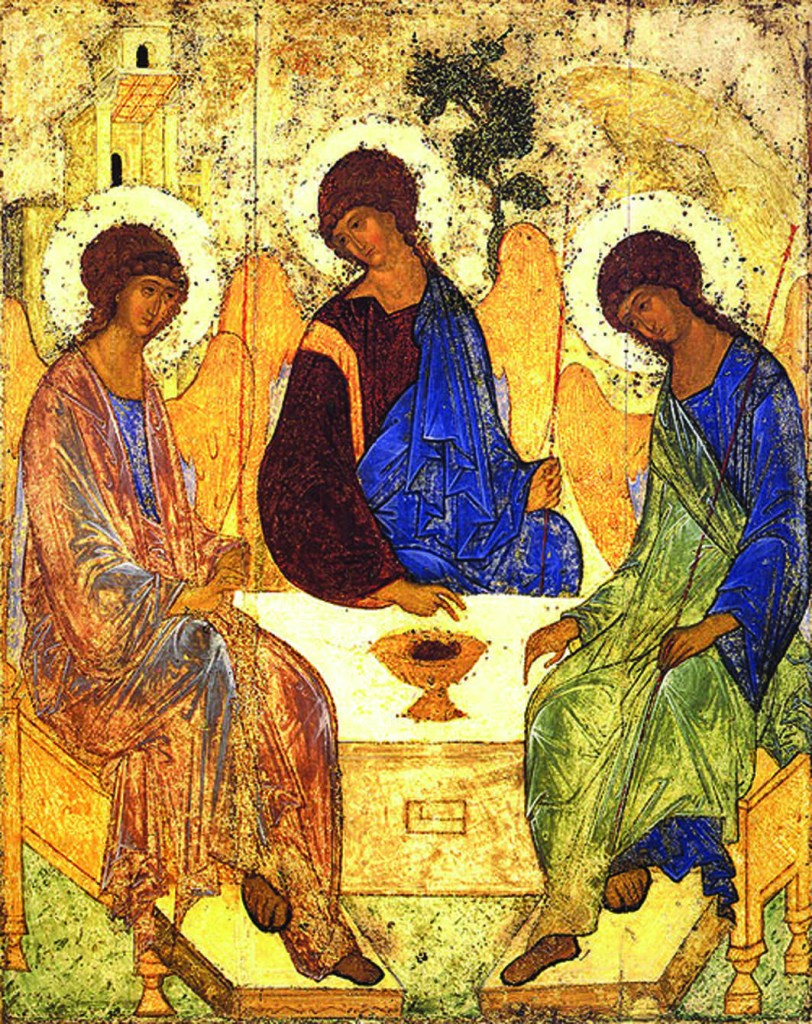
“The Trinity” by Andrei Rublev, Tretyakov Gallery, Moscow
The Trinitarian Icon
The Trinity as depicted by Andrei Rublev is arguably the most famous and best-beloved icons of all time. Most iconographers would agree that no one has ever surpassed the unity of composition, the balance of color and the sheer spirituality of this image; there literally is nothing else quite like this portrayal of God’s visit to Abraham.
All icons have a marked transcendent quality to them, perhaps easier to feel than describe. The Trinity image also provides an opportunity to explore transcendence on a note rarely ascribed to the spiritual realm: mathematics!
The spirituality of arithmetic is relatively easy to grasp. Whereas in the natural realm 1+1 generally results in 2 for an answer, spiritually we are well aware that 1+1+1=1 when speaking of the Trinity. Likewise, in speaking of sacramental marriage, 1+1=1. Icons take the spirituality of math a step beyond arithmetic and transform geometry into an expression of the ineffable.
Western art utilizes geometry to draw the eye and mind into the image and incorporate the viewer into the action. Geometry is used in a naturalistic fashion; an object in Western art appears smaller the farther away from the eye it lies. A house in the foreground will dwarf the mountains in the distance, for example.
A viewer is invited to enter the picture and journey through the image to those distant hills and thus explore the entire landscape. Eventually the viewer comes to the point where there is nothing left to discover and the picture “vanishes” into the distance.
In contrast, the icon uses a technique called “inverse geometry” to deliberately prevent the viewer from entering the icon. The geometric lines in iconography do not lead the eye into the image; in fact, a properly executed icon has a background of solid color or gold which reflects the eye back from the image! There is no background and no way to become a part of the image. The geometric lines in an icon do not converge in a “vanishing point” where the eye is led to a disappearance into the distance. Look at the footstools in the Trinity icon, for instance. If one draws out the lines from them, he finds that those lines will actually converge in the viewer. In other words, the viewer does not enter the icon, for the icon is quite clearly bridging the gap between heaven and earth; God “travels” through the medium of the image to lodge directly in the heart of the believer. The icon enters the viewer!
This unique use of geometry has sometimes been described as a sort of primitive art by Western critics, but some of them, drawn to explore the actual geometric structure, have had to conclude that the geometry of iconography is really more complex than that of the usual Western techniques. This cannot be otherwise, for God is an immensely larger subject for artistic treatment than a mere house situated near some mountains.
But what else can those geometric lines tell the viewer of the Trinity? Begin with the lines leading back from the footstools. Those lines will never converge in a vanishing point. They will continue on into infinity, never touching, always resulting in an ever-larger “space.” They do not end. So, behind the icon, where the human eye cannot penetrate, lies the realm of the infinite and everlasting God, the inner life of the Holy Trinity. The face of the icon is the realm of the Son, God as revealed, the depicted record of God active in the world and the flesh. Finally, before the icon, where the viewers dwell, is the realm of the Holy Spirit, coming into the world from the Father through the Son, entering human hearts to work the miracle of sanctification.
—Robert Wiesner




Facebook Comments